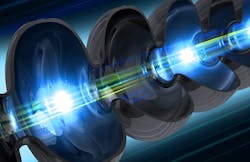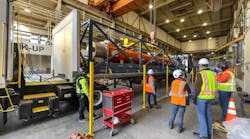SLAC’s LCLS-II, the world’s most powerful XFEL laser, sends first light
In this Q&A, Matthias Kling, LCLS Science and R&D director and professor of photon science at Stanford, Mike Dunne, LCLS director, and Dan Gonnella, Accelerator Directorate Superconducting Linac Physics Department head, answer Laser Focus World’s questions about the XFEL upgrade and what this engineering feat means for science.
After a $1.1 billion 10-year upgrade, the Linac Coherent Light Source (LCLS) x-ray free-electron laser (XFEL) at the U.S. Department of Energy’s (DOE) SLAC National Accelerator Laboratory is poised to revolutionize the ability of scientists to explore atomic-scale, ultrafast phenomena ranging from quantum materials to biological materials to fusion energy (see video).
At the heart of LCLS-II is a superconducting accelerator that comprises 37 cryogenic modules cooled to 2 kelvins above absolute zero (-456°F), at which it can boost electrons to high energies with nearly zero energy loss. LCLS-II also features a new electron source, two powerful cryoplants that produce refrigerant for the niobium structures in the cryomodules, and two new undulators to generate x-rays from the electron beam, as well as numerous advances in laser technology, ultrafast data processing, and sensors and detectors.
Reaching first light from LCLS-II required the extraordinary efforts of thousands of scientists, researchers, engineers, and technicians—congratulations to everyone involved!
Laser Focus World: What does LCLS-II mean for science?
Matthias Kling: This is a once-in-a-generation breakthrough in terms of our capabilities to take a deep dive into the microworld. LCLS-II is the brightest x-ray light source on the planet and features a factor of 8,000 increase in brightness over LCLS-I. This will allow us to record movies in down to atomic spatial and attosecond temporal resolution of the dynamics in matter as it does its business.
The repetition rate of LCLS-II can be fully tuned and reach up to 1 MHz, producing the type of data that will, for the first time, allow us to study rare but very consequential events, such as chemical transformations. Furthermore, this increase in rate will permit study of these transformations under conditions at which they occur in nature.
Along with the brand new superconducting accelerator, which we expect to provide higher stability and improved performance for user experiments, we completely overhauled our suite of experimental beamlines. They’re designed to provide new capabilities that fully exploit the new potential of LCLS-II and will allow us to study matter in completely novel ways with impact on science discovery toward drug discovery and human health, clean energy production, energy transport and storage, addressing grand questions in sustainability, microelectronics, and quantum materials for next-generation devices. This is one of the most exciting times for x-ray science.
LFW: Can you describe the laser’s upgrade, design improvements, and challenges along the way?
Mike Dunne: The primary improvement is the huge leap from 120 x-ray pulses/second to 1 million pulses/second. Another is the replacement of the single old ‘undulator,’ which generates the x-rays, with two new systems that allow dynamic scanning of the x-ray laser energy. Now we can easily track different elements in a molecule, for example, to watch how energy flows so we can drive improvements in the speed and efficiency of clean energy technologies and ultrafast computing.
There were many challenges! One was to ensure the cryogenic accelerator modules could be fabricated in one part of the country, at Fermilab and Jefferson Lab, and then transported to SLAC and welded together inside the tunnel—all without introducing a single speck of dirt inside the modules, which would destroy their performance.
This process took exactly 10 years. The updated ‘mission need’ statement from the U.S. Department of Energy was issued on September 27, 2013, and the final ‘completion’ review was on September 27, 2023.
Dan Gonnella: The accelerator was built with brand-new technology to make it more energy-efficient than previous superconducting accelerators. Developing this new technology took significant effort not only at SLAC, but also at Fermilab, Jefferson Lab, and Cornell University—leveraging decades of experience at these facilities. This efficiency allows the accelerator to be run at the high repetition rate that will enable new science. Developing a new technology that was critical to success during accelerator construction was especially challenging!
This video provides a simple explanation of what an XFEL is and what kinds of research scientists can do with this engineering marvel. (Video credit: Olivier Bonin/SLAC National Accelerator Laboratory)
LFW: Coolest things about the laser now?
Dunne: Well, the whole 700-meter-long accelerator is cooler than outer space—at just 2 kelvins above absolute zero! More seriously, the data rate that will be produced from this facility is immense. This will be one of the biggest data machines on the planet—generating up to 1 Terabyte of data/second—an Exabyte/year—that we’ll need to analyze in real time as data flows from the instruments.
This imposes an incredible challenge for the detector and data scientists—and will call for the use of artificial intelligence and the direct linking of LCLS to the world’s fastest supercomputers. Imagine watching 1,000 online movies simultaneously, each run at superfast speeds so they’re finished within just 1 second—and having to analyze every frame of the movie in real time to see if something unexpected appeared. And we need to do this 24/7 for dozens of different types of movies (a.k.a. experiments), so we need experts from almost every field of science and technology to collaborate to solve these immediate challenges.
LFW: Most surprising aspect of the upgrade?
Dunne: The most gratifying surprise is that even though these x-ray lasers require unbelievable precision and alignment, the system worked just a couple of hours after turning it on for the first time. There was great joy in the Accelerator Control Room when the first x-rays were seen on the screen—and then a lot of checking to make sure it was correct!
LFW: What does the LCLS-II enable in terms of applications?
Kling: One of the new instruments that will take full advantage of the LCLS-II is the qRIXS instrument. It will allow us to investigate excitations and their coupling in quantum and other materials in unprecedented detail.
So far, studies were predominantly performed without time resolution of the processes involved or the coupling of different excitations. If we want to optimize quantum materials or superconducting materials toward certain applications, a high degree of control of their quantum excitations is desired. Typically, nature doesn’t make this easy—multiple excitations can compete and limit the use of materials toward applications. Studying such excitations in the time domain will provide the means to not only further our fundamental understanding, but also applications where these materials can replace conventional rare earth materials in novel electronic devices, in quantum computing, etc.
Similar breakthroughs are expected in our ability to study chemical transformations at relevant conditions with applications including catalysis, combustion, and biochemical processes using a new instrument—ChemRIXS—optimized for this purpose. LCLS-II will allow us to record time-dependent resonant inelastic x-ray scattering from molecules going from their first heroic implementation with LCLS-I to becoming a standard technique.
LFW: What’s next?
Dunne: The pace of change is immense. We’re already midway through our next upgrade—LCLS-II-High Energy. This will double the energy of the accelerator and allow the x-rays to reach into the hard x-ray region to provide unprecedented spatial resolution of complex molecules such as proteins and technological materials.
There is also another upgrade running alongside this one, called MEC Upgrade, which will transform our ability to investigate fusion energy and the physics of the stars and planets—all down here on Earth.
Related Article

Sally Cole Johnson | Editor in Chief
Sally Cole Johnson, Laser Focus World’s editor in chief, is a science and technology journalist who specializes in physics and semiconductors. She wrote for the American Institute of Physics for more than 15 years, complexity for the Santa Fe Institute, and theoretical physics and neuroscience for the Kavli Foundation.




